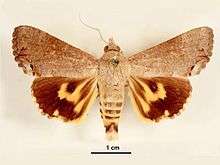Hypocala deflorata
Hypocala deflorata is a moth of the family Erebidae. It was first described by Johan Christian Fabricius in 1794. It is widespread from India, Sri Lanka to Africa and to Australia and many Pacific islands. Records include China, Borneo, Queensland, Vanuatu, New Caledonia, Rotuma, Fiji, Samoa, Hawaii, Norfolk Island and New Zealand.[1]
| Hypocala deflorata | |
|---|---|
 | |
| Female | |
 | |
| Male | |
| Scientific classification | |
| Kingdom: | Animalia |
| Phylum: | Arthropoda |
| Class: | Insecta |
| Order: | Lepidoptera |
| Superfamily: | Noctuoidea |
| Family: | Erebidae |
| Genus: | Hypocala |
| Species: | H. deflorata |
| Binomial name | |
| Hypocala deflorata (Fabricius, 1794) | |
| Synonyms | |
| |
Description
Full-grown larva are about 45 mm. There is a green and a black form, as well as an intermediate form with a mostly black head, and much blackish mottling on the dorsal part.[2]
The pupa is about 22 mm in length and is medium dark brown. Pupation takes place in a cell in the soil, or beneath trash on the surface. The cell is supplied with a few fibers of silk. The pupal period is 13–17 days.
In the adult, the head, thorax and forewings are pale violaceous grey. Hindwings with large orange area. Marginal black area reduced and the two orange spots conjoined. Ventral side black on forewing reduced to two bars, and that on hindwing also much reduced.[3]
Ecology
The larvae feed on Diospyros pallens, Diospyros villosa, Diospyros dichrophylla, Diospyros lycioides, Maba sandwicensis, Royena and Sapota species.[4]
Subspecies
- Hypocala deflorata deflorata
- Hypocala deflorata australiae (Queensland, Vanuatu, New Caledonia, Rotuma, Fiji, Samoa, Norfolk Island, New Zealand)
References
- "Hypocala deflorata Fabricius". The Moths of Borneo.
- Herbison-Evans, Don & Crossley, Stella (1 November 2014). "Hypocala deflorata Fabricius, 1794". Australian Caterpillars and their Butterflies and Moths. Retrieved 23 July 2018.
- Hampson, G. F. (1894). The Fauna of British India, Including Ceylon and Burma: Moths Volume II. Taylor and Francis – via Biodiversity Heritage Library.
- "Hypocala deflorata, (Fabricius, 1794)". African Moths.
External links
| Wikimedia Commons has media related to Hypocala deflorata. |
| Wikispecies has information related to Hypocala deflorata |
- Zimmerman, Elwood C. (1958). Insects of Hawaii. 7 Macrolepidoptera. University of Hawaii Press, Honolulu. hdl:10125/7336.